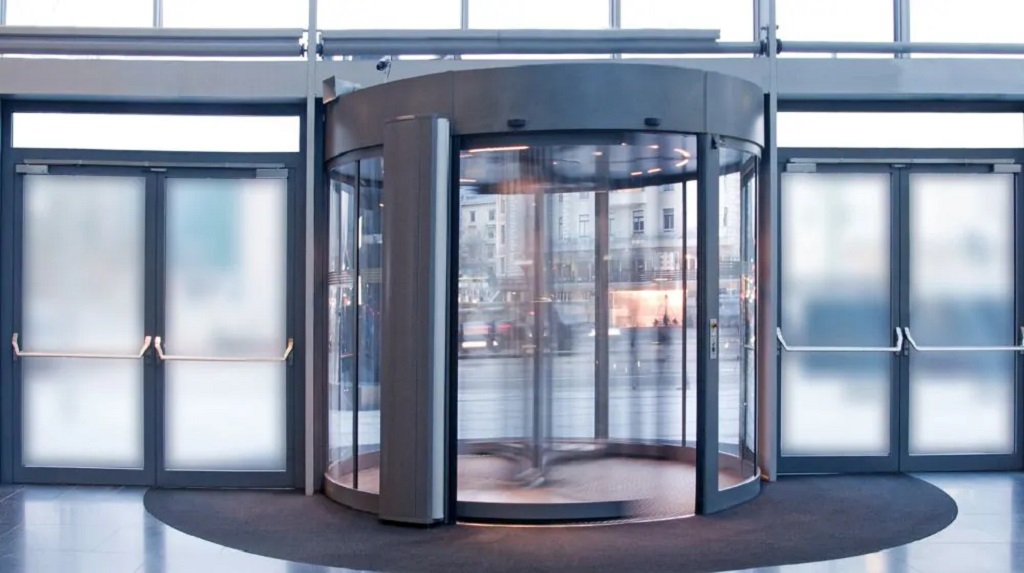Key Takeaways
- Revolving doors combine utility with aesthetic appeal and are essential in energy-efficient building design.
- The seamless integration of safety and advanced technologies in revolving door systems is paramount to their modern functionality.
- Understanding revolving door code compliance is crucial for architects and builders to ensure that revolving doors meet today’s performance and safety standards.
Understanding the Basics of Revolving Doors
A revolving door typically consists of three or four doors, referred to as wings or leaves, rotating inside a circular enclosure. This distinctive feature allows people to come in and go out without causing drafts, thereby maintaining the building’s internal environment. The concept of revolving doors dates back to the late 1800s when Theophilus Van Kannel registered the first patent. These doors were primarily created to prevent the gust of wind and the accompanying noise and debris. Nowadays, with advancements in materials and construction, revolving doors serve the primary function of ingress and egress and play a critical role in supporting revolving door code compliance standards that make them a smart option for contemporary infrastructure.
The Role of Revolving Doors in Modern Architecture
Modern architectural practices employ revolving doors as functional elements, statements of design ingenuity, and a testament to a building’s green initiatives. These doors blend seamlessly with glass facades and grand entrances, making them a go-to for architects aiming for a sleek, professional look. Beyond aesthetics, revolving doors serve as an airlock system, preventing excess air from entering or leaving the building, thus curbing energy loss and noise pollution. They function as silent gatekeepers of the indoor climate, further underscoring their valiant role against environmental challenges and their importance in a building’s sustainable design.
Enhancing Accessibility with Revolving Doors
Revolving doors have come a long way in becoming more inclusive and accessible. Innovations allow for adjustable speed controls to accommodate those who require more time to pass through and larger compartment sizes to fit wheelchairs comfortably. Ensuring compliance with accessibility standards such as the Americans with Disabilities Act (ADA) Standards for Accessible Design is a legal requirement and a commitment to inclusivity. Accessibility can no longer be an afterthought in design; it is a necessary consideration that reflects the ethics and values of our society.
Energy Efficiency and Sustainability
Regarding sustainability, revolving doors are a prime example of functional, energy-efficient design. They act as an ecological buffer, keeping out drafts and reducing the building’s energy consumption for heating, ventilation, and air conditioning (HVAC). This HVAC load reduction is beneficial for the environment and translates into significant cost savings over the lifetime of a building. Moreover, the energy conservation properties of revolving doors have been well-documented; as Scientific American reports, they can be a physical reminder for individuals to be more conscious of their energy use and environmental impact.
Advanced Technologies in Revolving Door Systems
Modern revolving doors are more than mere entry points; they can be equipped with sophisticated sensors and computer-controlled systems. These technological advancements respond to traffic flow, optimize energy usage, and even integrate with security systems to provide safe, monitored access. The increasing concern for security in public spaces makes such intelligent systems invaluable, ensuring that functionality does not come at the expense of safety.
Safety Features of Revolving Doors
Although revolving doors are engineered for seamless motion, user safety remains at the forefront of design considerations. Modern systems include a series of checks like speed control, touch-sensitive safety controls, and emergency stop features to prevent accidents. Mechanisms allow the doors to collapse or swing open during an emergency, facilitating quick and safe evacuation. Ensuring these safety systems are fail-proof is a testament to the industry’s commitment to user safety and building resilience.
Maintenance and Upkeep of Revolving Doors
Keeping revolving doors operating smoothly requires a proactive approach to maintenance. Regular cleaning and lubrication of mechanical parts, timely replacement of worn-out components, and comprehensive checks for any software updates are just a few of the tasks that ensure the longevity and reliability of revolving doors. Maintenance also ensures that doors meet the stringent revolving door code compliance standards by spotting potential issues before they escalate.
The Future of Revolving Doors
The industry can foresee revolving doors becoming increasingly integrated with building management systems, offering greater control over energy usage and pedestrian traffic. Anticipated advancements include using better construction materials, designs that are even more collaborative with environmental conditions, and systems that self-diagnose and report their maintenance needs. Moreover, legislation and public expectation will likely steer future designs to be more sustainable and accessible than ever before.
Choosing the Right Revolving Door for Your Project
Several factors come into play when deciding on the best revolving door for a building. One must consider the expected volume of foot traffic, the local climate, aesthetic preferences, and, most importantly, safety and compliance regulations. Collaborating with manufacturers who can provide bespoke solutions tailored to the specific architecture of the building can result in a more cohesive and efficient installation.
Real-life Examples and Testimonials
Businesses worldwide have discovered the multifaceted benefits of incorporating revolving doors into their premises. Owners of high-rise buildings, hotels, and corporate offices report a reduction in energy costs and an elevation in the building’s aesthetic and operational value. These real-life successes underscore the role of revolving doors as vital cogs in the machinery of modern, sustainable, and inclusive building design.

